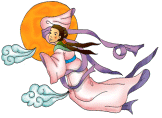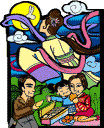Search
Related Articles
Chinese Culture >> Chinese Society, Traditions >> Chinese Mooncake Festival
Chinese Mid-Autumn,
Mooncake Festival
Originally named the Mid-Autumn Festival,
the Moon Festival is one of the most
important holidays celebrated by Chinese
communities around the world. Let us first
explore the creation of
mooncakes.
Mooncakes earned their popularity during the Yuan Dynasty (1200 A.D.- 1368 A.D) when, as legends say, the Mongols who had established the Yuan Dynasty were too oppressive, and were overthrown by the Chinese with the help of this simple dessert. Since Mongols did not eat mooncakes, the Chinese took advantage of this cultural difference and planned a revolt against them. Leaders of the revolts distributed mooncakes, under the pretense of celebrating the emperor's longevity, to other Chinese people. The mooncakes held secret messages baked within the skin, informing people to revolt on the 15th of the 8th moon, also the Mid Autumn festival. The rebellion was successful and mooncakes were forever kept a national tradition of China.
"When the moon is full, mankind is one" -- In China, the full moon has always represented the gatherings of friends and family. Thus, Mid-Autumn Festival is a time for family reunions. On this night, families will go together to scenic spots and parks for moon appreciation parties, and eating mooncakes.
 Traditionally,
Moon Cake Festival is celebrated on the
fifteenth day of the eighth lunar month in
observance of the bountiful Autumn harvest.
This year, Mid Autumn Festival is celebrated
on September 18. Although old rituals are no
longer followed, families continue to gather
for a day to relax and eat moon cakes. Upon
this occasion, the legend of the Moon
Goddess, CHANG-O, is often told to children.
Traditionally,
Moon Cake Festival is celebrated on the
fifteenth day of the eighth lunar month in
observance of the bountiful Autumn harvest.
This year, Mid Autumn Festival is celebrated
on September 18. Although old rituals are no
longer followed, families continue to gather
for a day to relax and eat moon cakes. Upon
this occasion, the legend of the Moon
Goddess, CHANG-O, is often told to children.
Once upon a time there
was a famous archer, Hou Yi, who with his
arrows was able to slay mankind’s worst
enemies, ferocious beasts that inhabited the
earth. Yi was married to Chang-O, a
beautiful but inquisitive woman who had been
an attendant of the queen mother of the west
before her marriage. Now at this time, there
were 10 suns that took turns circling the
earth-one every 10 days. One day, all 10 of
the orbs circled, together, causing the
earth’s surface to burn and threatening
mankind. The wise emperor of China summoned
Yi and commanded him to kill but one of the
suns. This Yi proceeded to do. Upon the
completion of his task, Yi was rewarded with
a pill, the elixir of life, and advised:
"make no haste to swallow this pill, but
first prepare yourself with prayer and
fasting for a year." Being a wise man, Yi
took the pill home and hid it under a rafter
while he began healing his spirit, In the
midst of this, Yi was summoned again by the
emperor.
While her husband was gone, Chang-O noticed a beam of white light beckoning from the rafter. She followed it and a fragrant perfume, discovered the pill and swallowed it. Immediately, Chang-O found she could fly. Just at that moment her husband returned home, realize what had happened and began to reprimand his wife. Chang-O flew out the window into the sky. Yi sped after her, bow in hand, and the pursuit continued halfway across the heavens. Finally, Yi had to return to the earth because of the force of the wind.
His wife reached the moon and there, breathless, she coughed and part of the pill fell from her mouth. Now, the hare was already on the moon and Chang-O commanded the animal to take pestle and mortar and pound another pill so that she return to earth and her husband. The hare is still pounding.
As for Yi, he built himself a palace in the sun as Yang (the sun and the male principle), Chang-O as Yin (the moon and the female principle).
Once a year, on the 15th day of the full
moon, Yi visits his wife. That is why the
moon is full and beautiful on that night.
Story by Thomas W. Chinn, Historian
Special Advertisement
